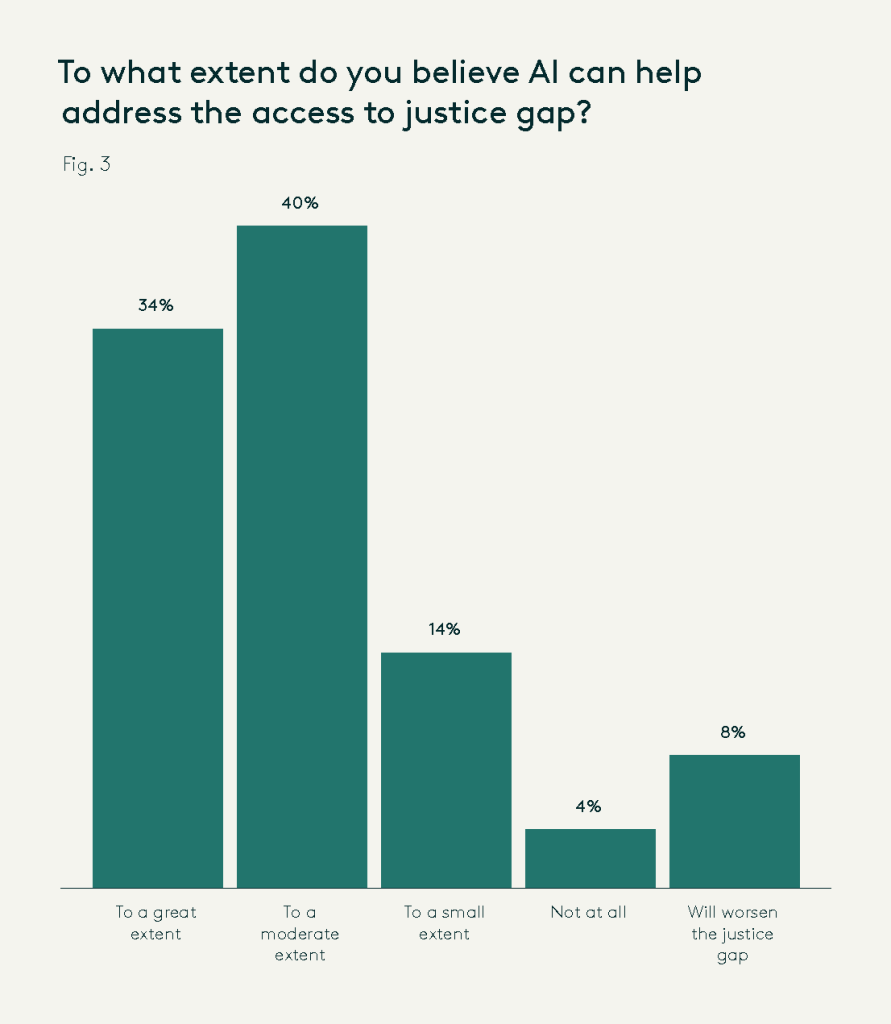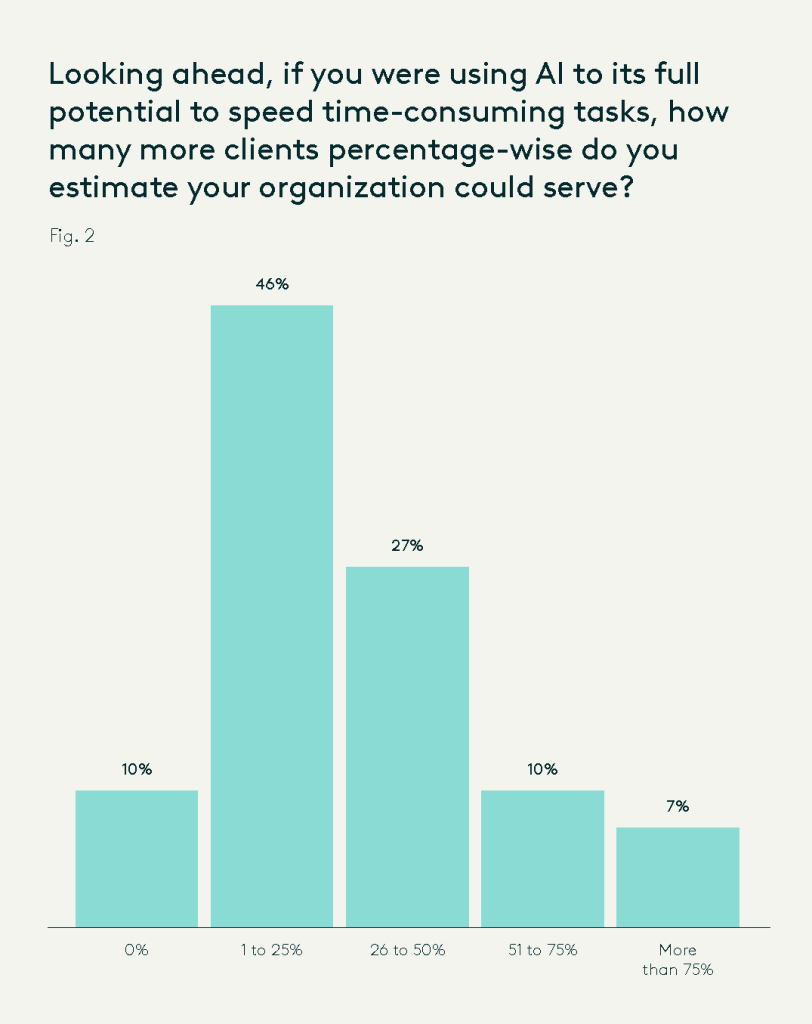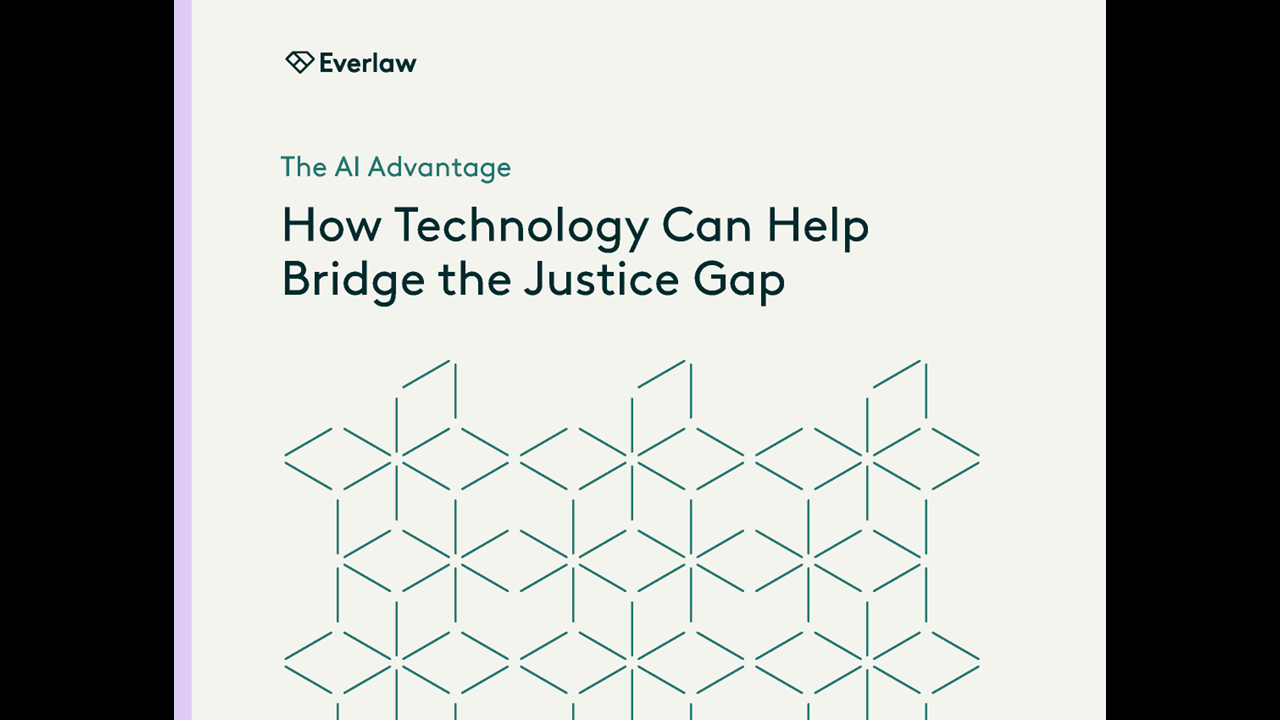A study examining artificial intelligence adoption in legal aid organizations has revealed that these resource-constrained nonprofits are embracing AI technology at nearly double the rate of the broader legal profession, driven by the urgent need to serve millions of underserved Americans.
The survey, The AI Advantage: How Technology Can Help Bridge the Justice Gap, was conducted by Everlaw in partnership with the National Legal Aid & Defender Association (NLADA), Paladin, and LawSites.
It found that 74% of legal aid organizations are already using AI in their work – significantly higher than the 37% adoption rate recently reported across the wider legal profession for generative AI tools.
AI As Justice Gap Solution
 The study’s most striking finding centers on legal aid professionals’ optimism about AI’s potential impact: 88% of respondents believe AI can help address the access to justice gap to some extent, with 34% saying it can help “to a great extent.”
The study’s most striking finding centers on legal aid professionals’ optimism about AI’s potential impact: 88% of respondents believe AI can help address the access to justice gap to some extent, with 34% saying it can help “to a great extent.”
This widespread belief in AI’s transformative potential comes against the backdrop of a stark justice crisis in America. According to the study, 92% of civil legal problems encountered by low-income Americans receive no or inadequate legal help, and the United States ranks just 107th out of 142 countries in affordability and accessibility of civil justice.
As I am quoted in the study as saying:
“This survey reveals that AI adoption is not just happening in well-funded BigLaw firms – it is being driven by organizations serving our most vulnerable populations When 88% of legal aid professionals see AI as a tool to address the justice gap, that underscores its potential to fundamentally democratize access to legal services.”
Regular Use of AI
The survey revealed significant integration of AI into the daily operations of legal aid organizations. Among the 112 legal aid professionals surveyed in May 2025:
- 40% reported using AI at least weekly.
- 26% use it daily.
- 12% use it multiple times per day.
Common applications include document summarization, legal research, analysis, translations, and development work – showing AI’s versatility across different aspects of legal aid practice.
Increasing Client Capacity
 The Legal Services Corporation estimates that nearly one of every two people who qualify for legal aid are turned away due to lack of resources.
The Legal Services Corporation estimates that nearly one of every two people who qualify for legal aid are turned away due to lack of resources.
For these legal aid organizations struggling with overwhelming caseloads, perhaps one of the survey’s most compelling findings is that 90% of respondents said using AI to its full potential would enable them to serve more clients.
When asked to quantify potential impact, respondents provided specific projections:
- 46% estimated they could serve 1-25% more clients.
- 27% believed they could serve 26-50% more clients.
- 17% projected capacity increases of over 50%.
“AI presents a generational opportunity to fundamentally expand who has access to justice, but it’s not a foregone conclusion,” said Joanne Sprague, head of Everlaw for Good. “By empowering these critical legal organizations with AI tools, we can make a real difference in the lives of millions.”
Implementation Challenges Remain
Despite widespread optimism, the survey identified significant obstacles to full AI implementation. The top areas of concern, ranked by severity, include:
- Data privacy and confidentiality (5.8 out of 10 on concern scale).
- Hallucinations and AI quality (5.6 out of 10).
- Ethical and professional responsibility (5.0 out of 10).
- Prohibitive cost (3.6 out of 10).
- Lack of technical resources (3.2 out of 10).
These challenges highlight the complex considerations legal aid organizations face when implementing AI, particularly given their ethical obligations to vulnerable client populations and limited financial resources.
Spotlight on North Carolina
The report spotlights Legal Aid of North Carolina (LANC) as an example of innovative AI implementation. The state’s largest nonprofit law firm serves 300,000 people annually seeking help with issues such as domestic violence and unlawful eviction.
LANC is testing an AI-powered voice agent for initial intake that operates 24/7 in multiple languages, addressing accessibility challenges for clients in rural areas or those with transportation issues.
By automating this foundational step, LANC’s 200 statewide attorneys can focus on high-value work such as court appearances and client advocacy, the survey notes.
“We will never be able to ‘lawyer ourselves’ out of this access-to-justice crisis,” said LANC’s Chief Innovation Officer Scheree Gilchrist in the survey report. “AI is a force multiplier to scale our services.”
A Powerful Tool for Legal Aid
According to experts cited in the report, the study’s findings align with broader observations about AI’s democratizing potential in legal services.
“Generative AI offers a rare chance to address this crisis,” said Kristen Sonday, cofounder and CEO of Paladin. “It can democratize legal information, simplify processes, and offer meaningful legal tools at scale.”
The survey results suggest that legal aid organizations view AI not as a threat to legal employment, but as a crucial tool for expanding access to justice. The technology appears to be enabling these organizations to stretch limited resources further while maintaining quality representation for vulnerable populations.
“Professionals across the access to justice community are embracing this technology as a crucial ally in the long-term fight to close the persistent justice gap,” the report concludes.
“This isn’t about automating jobs or taking work away from lawyers; it’s about equipping advocates with a powerful new instrument to manage complex caseloads, streamline tasks, and supercharge their capacity to serve more clients more effectively.”
Methodology and Participants
The survey was conducted in May 2025 by Everlaw in partnership with NLADA, Paladin and LawSites.
It surveyed 112 legal aid society professionals, examining their AI usage patterns, perceptions of AI’s potential to support access to justice, and views on how AI might help their organizations better serve people facing housing, family, employment, and other critical legal issues.
 Robert Ambrogi Blog
Robert Ambrogi Blog